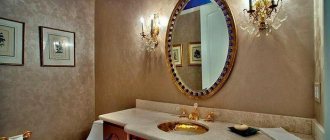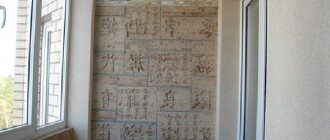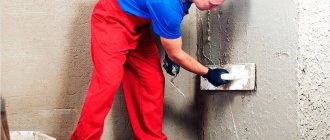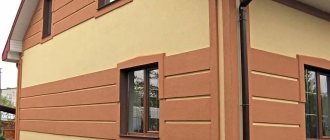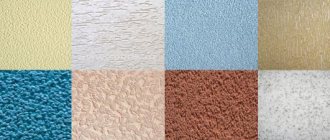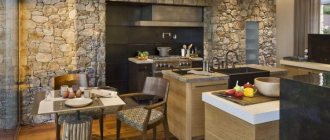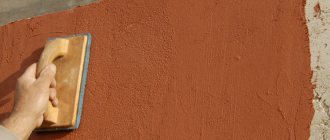Surfaces located outdoors are subject to special requirements for strength, durability, and aesthetic appearance. Walls are often covered with various finishing materials, for example, siding, fiber cement boards, thermal panels. However, plaster is often used as a finishing coating. True, its execution differs in the preparation recipe. The composition of plaster for external use with your own hands is characterized by environmental friendliness, durability, and useful physical characteristics.
Description of facade decorative plaster
The very name “plaster” came to us from the Italian language. Derived from the word "Stucco", which can be translated as alabaster, lime or gypsum. It was these materials that formed the basis of the first façade plaster compositions.
The main difference from other finishing materials is that plaster is applied directly to the surface itself , without lathing or frame structures.
This allows you to achieve maximum evenness of the wall, without resorting to sealing small cracks and knocking down protrusions, by only increasing the applied layer of the composition itself. Work on decorating the facade can be carried out either on a bare wall or with an additional thermal insulation layer.
Decorative plaster
Terraco Terracoat BT 25
Terraco Terracoat BT 25 is water-based with acrylic copolymers. Therefore, it can be applied at air temperatures from +5 to +30 degrees. After drying, the surface is absolutely resistant to moisture and sunlight.
Thanks to the fine grain, Terraco Terracoat BT 25 forms a beautiful sand pattern on the wall. Moreover, it contains no organic solvents, so the material can be considered environmentally friendly.
Among the advantages of facade plaster Terraco Terracoat BT 25:
- resistant to negative temperatures – F100;
- low consumption - only 0.7-0.9 kg per 1 m2;
- quick drying of the surface - 3 hours.
The main disadvantage of the plaster mixture is its high cost.
Types of decorative plaster for the facade of a house
Depending on the base on which the mixture is created, decorative facade plaster is divided into the following types:
Acrylic
Made from acrylic resin (the same material used to create PVA glue). It is produced ready-made and does not require additional mixing with other materials. Most often used for finishing surfaces with foam and polystyrene foam insulation.
Advantages of using acrylic plaster:
- The acrylic mixture is a vapor-permeable composition, which allows the walls to “breathe” even under a layer of decorative finishing;
- Plaster has the property of increased elasticity , the coating completely closes small cracks and gaps on the wall;
- The composition of the acrylic mixture must include bactericidal additives that protect the facade from the occurrence of fungal formations, dampness and mold.
- The plaster is sold ready-made , which significantly reduces the preparatory stage of façade finishing;
- Wide operating temperature range;
- The surface with an acrylic finish does not absorb moisture and dirt ; it can be washed with ordinary water;
- Acrylic plaster is a quick-drying finishing material.
Disadvantages of using acrylic plaster:
- Has increased electrostaticity. Simply put, dirt and dust easily stick to it.
IMPORTANT!
It is possible to paint the mixture in any color using a special tint.
Acrylic variety
Environmentally friendly plaster "Lamb" is produced by Farbe on an acrylic basis. This material allows you to create a unique texture with grain sizes of 1.5 and 2.0 mm.
At the same time, Farbe plaster is one of the leaders in its class in terms of efficiency . The average material consumption is 2.7-3.1 kg/m2.
Farbe acrylic plasters contain no solvent. It can be applied without any threat to health even in poorly ventilated areas.
Use both inside and outside the building.
One of the most important advantages of Farbe acrylic composition is its resistance to mechanical stress and various environmental influences. This plaster performs well in the harshest climates and protects the house from the sun, snow, rain and wind.
Like any acrylic-based material, “Lamb” plaster can be easily tinted in any of the shades (Symphone, NCS, RAL). Even under the influence of solar radiation, the material is able to retain its original color for 10 years.
Mineral
The fundamental substance of mineral plaster finishing material is cement . It is distinguished by its efficiency, since all elements of the composition have a fairly low price. Available in bags.
Advantages of using mineral plaster:
- Full vapor permeability;
- Resistance to the harmful effects of biological organisms (mold, fungus, etc.);
- Absolutely fireproof material;
- After application and complete drying, such plaster will not shrink or crack ;
- Frost-resistant;
- Moisture resistant;
- Works effectively under the influence of both low and high temperatures;
- Eco-friendly material;
- Does not require additional care, easy to clean;
- Has a relatively low price.
Disadvantages of using mineral plaster:
- Release form: dry substance . To create a ready-made solution, the bagged mixture must be diluted in certain proportions. If the requirements are not met, the composition may become unsuitable for work;
- The installation of such finishing is a rather labor-intensive process and requires the worker to have certain skills and experience working with this kind of material ;
- The narrow range of colors significantly narrows the possibilities of using this plaster. It is possible to give the required shade only with the help of additional coloring of the already dried plastered base, which increases both monetary and labor costs;
- Susceptible to vibration vibrations;
- Guaranteed service life is only 10 years.
NOTE!
Subsequent painting of the plastered surface can only be carried out 2 days after its application.
Mineral variety
Silicone
The basic substance of this composition is silicone resin . It is in many ways similar to acrylic resins, but has higher elasticity. By purchasing such a mixture, you are purchasing a plaster composition that is ready for application.
Advantages of using silicone plaster:
- Thanks to its elasticity , it can tighten both existing cracks and cracks that arise during shrinkage on the façade of a building;
- High biological stability;
- It is a water-repellent finishing material;
- Vapor permeable;
- Even when exposed to low subzero temperatures, it does not lose its properties;
- Possibility of application both manually and mechanically;
- When applied, a strong bond is created between the surface to be plastered and the composition itself;
- Does not have an unpleasant odor ;
- Durability (guaranteed service life - 25 years).
Disadvantages of using silicone plaster:
- High price;
Silicone variety
Plastering facades not only helps solve design problems, but also significantly improves the performance characteristics of any building. A layer of plaster improves thermal insulation, protects load-bearing walls from precipitation and allows you to hide minor construction flaws.
The only drawback of classic plaster is its fragility and high consumption of material. It is much wiser to use polymer-based plaster as a more modern and effective finishing material
Compared to mineral-based materials, Farbe silicone plaster has the following advantages:
- elasticity that prevents the formation of cracks on the walls;
- the ability not to allow moisture to pass into the surface, but at the same time to release vapors outside;
- long-term preservation of the original color even in direct sunlight;
- ability to self-clean with rainwater.
The range of applications for silicone plasters can be expanded due to the possibility of tinting. There are about 2,500 different shades, allowing you to very accurately realize any designer’s plan.
In this case, the service life of the plaster is at least 25 years. In most cases, this means that a cottage that has been plastered once will not require cosmetic repairs until almost the end of its life.
Silicate
The fundamental substance included in this type of material is “liquid” glass . Most often used for plastering facades insulated with mineral wool boards or expanded polystyrene. Sold ready for use.
Advantages of using silicate plaster:
- Not electrostatic;
- Has the property of high elasticity;
- Vapor permeable;
- Hydrophobic;
- Easy to care for;
Disadvantages of using silicate plaster:
- Requires the finisher to have certain knowledge, skills and experience;
- Dries quickly;
- To finish this type of decorative facade plaster, it is necessary to carry out additional preliminary work on priming the base . This significantly increases the time spent decorating the exterior of the building.
Silicone variety
Peculiarities
Plastering allows you to quickly repair and transform the facade of a house. The mixture acts as an additional insulating layer, creating a durable coating that protects against negative environmental factors. The plastering process levels the walls and improves sound and thermal insulation characteristics.
Facade plaster is one of the most popular materials for finishing residential buildings
The use of the best facade plaster is not just decoration, but also extends the life of the building.
Material requirements
The finish adheres well to the surface only if all the necessary requirements were taken into account when choosing it:
- Resistance to sudden temperature fluctuations. The mixture must have a wide range of acceptable temperatures.
- Moisture resistance. One of the purposes of the coating is to protect the building from water. It should not absorb or accumulate moisture.
- Fire safety. The layer should not ignite under the influence of high temperatures and fire.
- Vapor permeability. The surface must breathe. This property of the material helps maintain optimal climatic conditions indoors.
- Adhesion to the base. Good adhesion ensures the creation of a reliable monolithic layer that will not peel off.
- Strength. The plastered wall must be resistant to loads and mechanical stress.
Mixtures for facades must have strength, good vapor permeability, and excellent adhesion
Among the secondary, but no less important criteria are aesthetic appearance, light weight and ease of maintenance.
What to consider when choosing
In addition to the basic requirements, there are criteria that must be taken into account when choosing a solution.
- Seasonal temperature changes. Each mixture has a limited freeze-thaw cycle. This indicator must be taken into account when working in a cold climate zone.
- High humidity. For areas with high humidity, moisture-resistant brands are preferred.
The façade of the building must be easy to clean and maintainable.
Facade plaster will protect walls from the effects of adverse climatic factors and increase the service life of the building
Types of textures of decorative facade plasters
To give the greatest aesthetic appeal, various types of textured application of plaster compositions are used.
Depending on the means and methods of creation, textures are divided into:
- Traditional . They are created on the basis of both mixtures of old and new generations. They have a texture depth of up to 0.5 cm.
- Modern . Created using only the latest materials.
Among modern textures the following categories can be distinguished:
- "Pebble" . Pebble textured plaster includes small granular formations with a size of 1 to 3 mm . It is a universal option, since based on it you can create both shallow bas-reliefs and “sgraffito”, “fur coat”, “polka dots”, etc. Giving relief is achieved by rubbing the composition applied to the façade with a plastic float. Additional tools such as a trowel, various rollers, brushes, etc. can also be used.
- "Bark beetle." One of the most common textured plasters. With its help, both vertical and horizontal, wave-like furrow patterns are created. It is applied similarly to pebble textured plaster.
- "Mosaic" . This type of texture is created on the basis of silicone or silicate plaster, to which coarse stone chips are added. Multi-colored granules form unique mosaic patterns on the plastered surface , reminiscent of mountain minerals. The application method is similar to pebble textured plaster.
Material texture
Ceresit CT 175 “Bark beetle” (grain 2 mm)
After hardening, Ceresit CT 175 “Bark Beetle” plaster has a large texture with fractions protruding outward, which looks good on the facade of commercial and residential real estate. The material is supplied in 25 kg buckets. The maximum application layer is 2 mm.
Ceresit CT 175 contains silicate. It is liquid potassium glass, which significantly increases the water-repellent characteristics of the material. It is recommended to apply plaster at temperatures from +5 to +30 degrees. The surface hardens very quickly - in 5 hours. This façade is not susceptible to cracking and fungus formation.
Advantages of Ceresit CT 175 “Bark Beetle” plaster:
- resistant to moisture and mechanical damage;
- not afraid of temperature changes in the off-season;
- service life from 20 years.
The disadvantages of the material include that it is sold as a base and requires subsequent tinting before application.
Selection rules
When selecting a composition for finishing a facade, you need to pay attention to the following characteristics:
- Compressive strength. The value of this indicator should always be less than that of the surface to be plastered;
- Preferred type of plaster (choose the appropriate one based on the set of positive and negative qualities given above);
- By area of application;
Some compositions can only be used for certain types of walls.
- Can be used for exterior decoration of buildings;
- You should choose plaster for exterior work with a maximum adhesion value , because it is this that indicates the degree of adhesion to the decorated facade;
- Range of possible thickness of the plaster layer;
- Vapor permeability coefficient value . The higher it is, the better your walls will “breathe”.
- The amount of mixture in the package and its consumption per 1 sq. m. Using these values, you can not only determine how many packages are required for a particular building, but also calculate the economic benefit of the purchase.
Mixture consumption per square meter
Since this type of finishing material involves mixing dry matter with water, to calculate the mixture consumption you need to resort to the following simple calculations:
First you need to look at the recommendations on the dosage of dry matter and the required water on the packaging.
For example, it states that for 1 square meter of surface, when applying plaster with a layer of 10 mm, 9 kg of dry base will be required.
Then, to finish the facade with a layer of plaster, the average thickness of which will be 2.5 cm (choose your value in accordance with the recommendations on the packaging), you will need:
9kg * 2.5 = 22.5 kg of dry matter per 1 square meter.
In order to find out how much plaster is needed to finish the entire facade, you need to multiply its area by the dry matter consumption per 1 sq. m . That is, for a facade with an area of 20 sq.m. the calculation will look like this:
22.5 kg * 20 = 450 kg . This number is the final mass of the dry mixture for finishing.
To find out the number of packages that you need to purchase to plaster the entire surface to be decorated, you need to divide the required mass by the weight of the dry substance in 1 package.
That is, if you plan to purchase 50-kilogram bags, then their quantity will be equal to: 450 kg/50 kg = 9 pcs.
IMPORTANT!
If the number of packages is not a whole number, then its value must be rounded to a larger number.
In the case of other types of plaster compositions, the situation is much simpler, since they are already ready for use. You need to look at the label for what area this particular amount of substance is designed for, and then calculate the required number of packages in accordance with your area.
Weber Pas ExtraClean
Weber Pas ExtraClean facade plaster is applied with a layer thickness of up to 1.5 mm. Supplied in 24 kg buckets, completely ready for use. Initially, the material is white, but it is possible to add color to obtain one of 218 shades.
Pas ExtraClean plaster sets quickly, but requires 24 hours to dry completely. The finished surface is highly resistant to moisture, chemical environments, including alkaline ones, ultraviolet radiation, and exhaust gases.
It is recommended to apply the plaster composition at air temperatures from +8 to +30 degrees. Approximate material consumption during application – 2.4-2.6 kg/m2
Advantages of Weber Pas ExtraClean facade plaster:
- has a self-cleaning effect;
- high level of vapor permeability;
- increased elasticity and frost resistance.
The availability of only white plaster for sale can be called the only drawback of the material. This problem is easily solved by coloring.
Instructions for plastering using insulation
The installation of a decorative layer of plaster on the facade is carried out in the same way for all types of insulation.
The work is being carried out in the following order (photo below):
- Prepare the mixture (if mineral plaster is used), submit it to the construction site;
- Using a special adhesive composition, you need to glue a special façade reinforcing mesh to the heat-insulating layer.
- Grout the reinforcing layer using a special plastic float.
CAREFULLY!
You can rub over only after the adhesive base has completely dried.
- At this stage, you need to apply a layer of universal leveling agent, which will serve as the basis for further finishing;
- Grouting the leveling layer;
- If necessary, prime the base;
- You can start applying plaster.
Schematic device
Plastering the facade
Application technique
The plaster is applied manually using spatulas or special spray guns. The mixture can be used separately or reinforced. To do this, use a façade mesh for plaster . Its threads are thin, but perform a function similar to metal rods in concrete blocks.
Otherwise, the technique of applying plaster depends on the type of base:
- Mixtures are easiest to apply on brick and aerated concrete. They work with a wide trowel. It is placed almost perpendicularly to the bottom of the building and led upward, stretching the mixture, reducing the angle of inclination of the tool. At the end it is almost parallel to the wall. After processing approximately 1.5 squares, take a grater, giving the surface texture.
- A reinforcing fiberglass mesh with a density of 160 grams per square meter must be placed over foam plastic and mineral wool. The insulation is not primed, but the base layer is treated. The plaster is first applied to slopes, corners and other surfaces of complex configuration. Perforated corners will be required. A mesh is attached to them. This detail improves the adhesion of the plaster to the folds of the facade. On its main planes, the coating is applied over the mesh from the corners to the center. The reinforcing layer should be buried in 2-3 millimeters of solution. Level with a wide spatula. The joints of the mesh, which is cut into one and a half meter pieces, should not coincide with the seams between the insulation boards. The plaster base is rubbed down and leveled. All that remains is to apply the finishing coat. A more liquid solution is used for it.
- On a tree. The plaster protects the base from drying out, rotting, termites and rodents. Wood is a vulnerable material. Before plastering, you need to fill all the cracks and secure the reinforcing mesh. Instead of fiberglass, shingles are usually used. This is covering the facade with slats in 5-centimeter increments. The first row is positioned at a 45-degree angle, and the second at a right angle. There should be at least 1.5 centimeters of plaster on top of the second layer of shingles. First, it is diluted liquidly and sprayed on the walls. A centimeter layer is thrown on. When it dries, apply the bulk of the coating. They throw it with a ladle. All cavities in the shingles should be filled. I usually solve the problem with rough plaster. The decorative facade becomes only the final layer, protecting and decorating the previous ones.
When working with acrylic plaster, you need to adjust to a consumption of 1.5-3 kilos per square. The silicone mixture will require from 2.5 to 4 kilograms. The consumption of mineral plasters per square meter is 2.6-4 kilos.
Brick finishing technology
The sequence of work on finishing a brick facade is as follows:
- Prepare and prepare the plaster mixture according to label requirements;
- Deliver the mixture to the construction site;
- Prime the brick wall;
- Attach metal beacons to the wall structure;
- Moisten the surface to be plastered to increase the drying time of the finishing composition;
- Stir the plaster solution until smooth;
- Spray the mixture onto the wall;
- Level the surface using a spatula from bottom to top;
- Having completed application to a large area, you need to apply a long rule over the entire surface. This will allow the layer of plaster to be leveled as much as possible;
- On the damp surface, use a scraper to scratch small grooves , which will serve for bonding with the next layer (rolling);
- After the first layer has dried, we begin to apply the finishing finish;
- Smooth and level the plaster layer.
Tips for a developer - how to plaster walls correctly
There is little theoretical knowledge to perform plastering work. To obtain high-quality coverage, long-term practice and skill of the performer are of great importance. To make the facade of the house look decent, I highly recommend entrusting this work to specialists with good recommendations.
Start plastering the walls no earlier than 2 - 3 months after the roof of the house has been erected. The walls will shrink during this time.
Plaster the facade after finishing the plastering work inside the house.
Ideal weather conditions for installing external plaster are temperatures in the range of plus 5 - 25 ° C, air humidity no more than 75%. In hot weather, freshly applied plaster on the wall is protected from the sun, and mineral plaster is also sprayed with water. Otherwise, the plaster layer may crack.
Before applying the plaster mortar, it is very useful to coat the wall surface with a primer. It is better to choose a primer recommended by the manufacturer of the ready-made solution or dry mixture. This information is usually found on the packaging or on the manufacturer's website. The primer improves the adhesion of the plaster layer to the base, reduces the risk of cracks and peeling of the plaster from the base. Don't skimp on primer - you could lose more.
On smooth and primed walls, plaster can be applied in two layers , as shown in this master class video.
Plastering external walls made of aerated concrete, gas silicate from the inside of the room.
More articles on this topic:
⇒ Which facade paint to choose. ⇒ Painting the facade and exterior walls of the house
More articles on this topic
- The procedure and stages of construction of a private country house, cottage
- Ground ventilation heat exchanger in a private house
- Painting the facade and exterior walls of the house
- Prefabricated monolithic frequently ribbed floors made of light stone blocks
- Built-in dressing room in a house or apartment
- How to properly make a chimney for a boiler in a private house
- Cheap shallow foundation for a house in a swamp
Do-it-yourself façade plaster on a wooden base
Sequence of work:
- Cleaning the wall;
- Applying notches;
- Create a sheathing from a specialized mesh with large cells, or build a frame from shingles;
- The further sequence is similar to the technology of plastering on brick (starting from point 6).
Installation of sheathing
Plastering a facade is a rather labor-intensive process that cannot always be done independently. However, using this finishing option, you can achieve maximum aesthetic appeal of your home.




